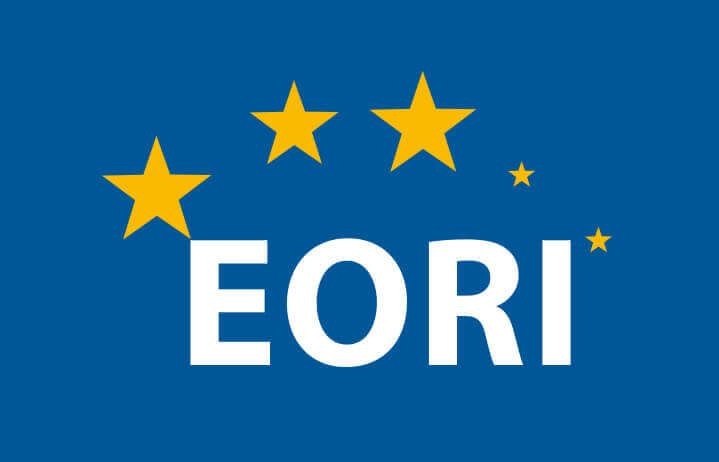FIATA documents and forms
FIATA Documents and Forms
Indeed, more than 30 years ago it was felt by the forwarder profession that they should have our own freight forwarders documents and for this reason FIAT A created
- in 1955 the FIAT A FCT- FIAT A Forwarders Certificate ofReceipt (green col our)
- in 1959 the FIAT A FCT – FIAT A Forwarders Certificate of Transport (yellow colour)
- in 1970 the FBL -FIAT A Negotiable Combined Transport Bill of Lading (blue colour)
- in 1975 the FWR- FIA TA Warehouse Receipt (orange colour)
as unifonn standard documents with distinctive colour.
In the meantime most of our member countries have introduced one, two or all of our documents. Millions of copies of the FIAT A FCR, the FIAT A FCT, the FBL and the FWR have been issued. Not a single case of juridical dispute has come to our knowledge and this is evidence of the competence and integrity of the freight forwarding issuing these documents. Furthermore, the FIAT A FCR, FIAT A FCT and FBL have been recognised by the International Chamber of Commerce in 1975 in their Doc. 470/251. FIATA documents have an excellent reputation and are recognised as documents of tradition and trust. They have greatly contributed in the past to the facilitation of international exchanges and will continue in the future to be valuable instruments in the service of World Trade.
General Stipulations
- The authority to control printing and distribution of our documents is restricted to the member organization of FIATA.
- National Freight Forwarders Organizations are responsible for the printing of the document in English, French and German, with regard to text and layout, of the authorised specimen, if necessary, it is also permitted for a text in the organization’s national language to be incorporated in the document in addition to one of the three FIATA languages. Member organizations are required to mark the documents they distribute with a suffix letter corresponding to the international vehicle # registration of the home country. For example:
- AUSTRIA A
- BELGIUM B
- SWITZERLAND CH
- A serial number is required for the FIATA FCR and FIATA FCT. For the FBL and FWR numbers are not required but may be used in countries where they would be convenient.
- Before issuing FIATA documents, the member organizations, have to submit proof prints to the FIATA Secretariat for approval.
- FIATA documents are distributed by the national organizations affiliated to FIATA to their member firms in accordance with official instructions and explanatory notes on its use. To control the issue of these documents the national organizations maintain a register of member firms who have received copies of the documents, indicating their serial number.
- FIATA has copyright on the FIAT A FCR, FIAT A FCT, FBL and FWR. Reproduction of the documents by individual firms in any form is strictly prohibited.
FIATA FCR Forwarders Certificate of Receipt
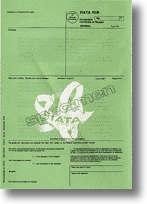 The Forwarders Certificate of Receipt was in-troduced by FIATAfor the use by international freight forwarders within the Organization of FIATA. The FIATA FCR document enables the freight forwarder to provide the consignor with a specialdocument as an official acknowl-edgement that he has assumed responsibility of the goods. The FIATA FCR can be handed to the con-signor immediately after the consignment has been received by the freight forwarder. By completing the FIATA FCR the freight for-warder certifies that he is in possession of a specific consignment with irrevocable instruc-tions for despatch to the consignee shown in the document or to keep it at his dsiposal. These instructions may only be cancelled if the original FIATA FCR document is handed over to the issuing freight forwarder and only if he is in a position to comply with such cancellation or alternation The FIATA FCR will primarily be used when the supplier sells the goods ex works and needs to prove that he has complied with his obliga-tions to the buyer by presenting a FIATA FCR In the case of a Letter of Credit the seller will under such conditions be able to present a FIATA FCR issued by a forwarder in order to obtain payment of the sales price placed at his disposal by the buyer under the terms of the Letter of Credit. The seller can no longer dis-pose of goods handed over to the forwarder once the FIATA FCR document has been handed over to the buyer. 9 The FIATA FCR is not negotiable. As the deliv-ery of the consignment to the consignee does not depend on the handing over of this docu-ment, only one original is issued. Should fur-ther copies be required, forms specially over-printed with the words “Copy not negotiable should be used.
The Forwarders Certificate of Receipt was in-troduced by FIATAfor the use by international freight forwarders within the Organization of FIATA. The FIATA FCR document enables the freight forwarder to provide the consignor with a specialdocument as an official acknowl-edgement that he has assumed responsibility of the goods. The FIATA FCR can be handed to the con-signor immediately after the consignment has been received by the freight forwarder. By completing the FIATA FCR the freight for-warder certifies that he is in possession of a specific consignment with irrevocable instruc-tions for despatch to the consignee shown in the document or to keep it at his dsiposal. These instructions may only be cancelled if the original FIATA FCR document is handed over to the issuing freight forwarder and only if he is in a position to comply with such cancellation or alternation The FIATA FCR will primarily be used when the supplier sells the goods ex works and needs to prove that he has complied with his obliga-tions to the buyer by presenting a FIATA FCR In the case of a Letter of Credit the seller will under such conditions be able to present a FIATA FCR issued by a forwarder in order to obtain payment of the sales price placed at his disposal by the buyer under the terms of the Letter of Credit. The seller can no longer dis-pose of goods handed over to the forwarder once the FIATA FCR document has been handed over to the buyer. 9 The FIATA FCR is not negotiable. As the deliv-ery of the consignment to the consignee does not depend on the handing over of this docu-ment, only one original is issued. Should fur-ther copies be required, forms specially over-printed with the words “Copy not negotiable should be used.
When issuing a FIATA FCR the freight for-warder should ensure:
- that he or his agent (branch, intermediate freight forwarder) has taken over the con-signment specified therein and that the right of disposal of the goods is vested solely in him;
- that the goods appear to be in apparent good order and condition;
- that the details on the document clearly correspond with the instructions he has received;
- that the conditions of freight documents (B/L etc.) are not contrary to the obligationshe has assumed according to the FIATA FCR document.
The FIATA FCR bears the general national freight forwarding conditions of the issuing country on the reverse. The document may only be used by freight forwarders who ad-here to these general conditions in their for-warding activities. It is recommended that the freight forwarder covers his liablility by insurance in accordance with the FIATA FCR requirements.
FIATA FCT Forwarders Certificate of Transport
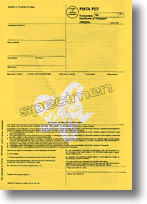 The Forwarders Certificate of Transport was introduced by FIATA for the use by inter-national freight forwarders within the FIATA Organizations. By issuing a FIATA FCT document to the con-signor, the freight forwarder assumes the obligation to deliver the goods at destination through the medium of an agent appointed by him. The FIATA A FCT can be handed over to the consignor immediately after the consignment has been handed over to the freight forwarder for shipment. By issuing the FIATA A FCT the freight forwarder certifies that he has assumed responsibility for dispatch and delivery of a specific consign-ment according to instructions he has re-ceived from the consignor as indicated in the document. The freight forwarder is responsible for the de-liveryof the consignment at destination through a delivery agent appointed by him to the holder of the document in accordance with the conditions stipulated on the reverse of the FIATA A FCT. The FIATA FCT has a “block” function. The freight forwarder is only responsible for the forwarding and delivery of the goods. The FIATA FCT, as distinguished from the FBL, is not a document subjecting the freight for-warder to a liability as carrier but his liability is governed by the applicable freight forwarding conditions. The FIATAA FCT will therefore be of importance in all cases where the transport has to be arranged for delivery to the consignee. The seller will be able to obtain payment of the sell-ing price from his bank against the FIATA FCT “cash against Documents”.The FIATA FCT is negotiable when made out “to Order” (see also ICC Doe. 470/251 Art. 24). The FIATA FCT is negotiable as the delivery of the consignment may only be effected against presentation of the original document, dulyendorsed.
The Forwarders Certificate of Transport was introduced by FIATA for the use by inter-national freight forwarders within the FIATA Organizations. By issuing a FIATA FCT document to the con-signor, the freight forwarder assumes the obligation to deliver the goods at destination through the medium of an agent appointed by him. The FIATA A FCT can be handed over to the consignor immediately after the consignment has been handed over to the freight forwarder for shipment. By issuing the FIATA A FCT the freight forwarder certifies that he has assumed responsibility for dispatch and delivery of a specific consign-ment according to instructions he has re-ceived from the consignor as indicated in the document. The freight forwarder is responsible for the de-liveryof the consignment at destination through a delivery agent appointed by him to the holder of the document in accordance with the conditions stipulated on the reverse of the FIATA A FCT. The FIATA FCT has a “block” function. The freight forwarder is only responsible for the forwarding and delivery of the goods. The FIATA FCT, as distinguished from the FBL, is not a document subjecting the freight for-warder to a liability as carrier but his liability is governed by the applicable freight forwarding conditions. The FIATAA FCT will therefore be of importance in all cases where the transport has to be arranged for delivery to the consignee. The seller will be able to obtain payment of the sell-ing price from his bank against the FIATA FCT “cash against Documents”.The FIATA FCT is negotiable when made out “to Order” (see also ICC Doe. 470/251 Art. 24). The FIATA FCT is negotiable as the delivery of the consignment may only be effected against presentation of the original document, dulyendorsed.
When issuing the FIATA FCT document the freight forwarder should ensure:
- that he or his agent (branch, intermediate freight forwarder) has taken over the con-signment specified therein and that the right of disposal of the goods vested solely in him;
- that the goods appear to be in apparent good order and condition; that the details on the document clearly correspond with the instructions he has received;
- that conditions of freight documents (B/L etc.) are not contrary to the obligations he has assumed according to the FIATA FCT document;
- that responsibility for the insurance of the consignment has been agreed;
- that it is clearly specified whether one or more originals have been issued.
It is recommended to dispatch the FIATA FCT documents by registered post only.The FIATA FCT bears the general national for-warding conditions of the issuing country on the reverse. The document may only be used by freight forwarders who adhere to these general conditions in their forwarding activi-ties. Greatest possible care must be taken in the preparation of these documents as the partic-ulars contained therein must reflect accurately the full details of the consignment, approved that a fee covering the preparation of the document by the issuing freight forwarder is therefore agreed and justified.
FBL – Negotiable FIATA Combined Transport Bill of Lading
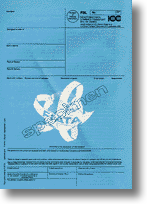 The FIATA Multimodal Transport Bill of Lading (FBL) is a carrier-type transport document set up by FIATA for the use by freight forwarders acting as multimodal transport operators (MTO).The FBL can also be issued as a marine bill of lading.The document is negotiable unless marked “non-negotiable”. It has been deemed by the International Chamber of Commerce (ICC) to be in conformity with the UNCTAD/ICC Rules for Multimodal Transport Documents pub-lished by ICC in its brochure No. 481. There-fore, the FBL bears the ICC logo alongside the symbol of the national #freight forwarders as-sociation. Furthermore, the Negoriable FIATA Multimodal Transport Bill of Lading is referred to in the “Guide for Documentary Credit Operations for the Uniform Customs and Practice for Docu-mentary Credits (UCP 500)” of ICC (ICC publi-cation No.515) as an acceptable freight for-warders transport document. A freight forwarder acting as MultiTransport Operator (MTO) or marine carrier is-suing a FBL is responsible for the performance of transport. The freight forwarder does not only assume responsible for delivery of the goods at destination, but also for all carriers and third parties engaged by him for the per-formance of the whole transport. By issuing a FBL the freight forwarder accepts a basic liability limit of 666.67 SDR per package .or unit, or 2 SDR per kilogramme of gross 22 weight of the goods lost or damaged, whichever is the higher (Art. 8.3 of the FBL conditions), or, if a multimodal transport does not indude carriage of goods by sea or inland waterways, a basic liability limit of 8.33 SDR per gross weight (Art. 8.5 of the FBL condi-tions). When loss of or damage to the goods can be attributed to a particular stage of trans-port in a multimodal transport operation, the freight forwarder’s liability is limitedaccording to mandatory national or international lawap-plicable to this stage of transport (Art. 8.6.a of the FBL conditions). When issuing a FBL, the freight forwarder shouldensure:
The FIATA Multimodal Transport Bill of Lading (FBL) is a carrier-type transport document set up by FIATA for the use by freight forwarders acting as multimodal transport operators (MTO).The FBL can also be issued as a marine bill of lading.The document is negotiable unless marked “non-negotiable”. It has been deemed by the International Chamber of Commerce (ICC) to be in conformity with the UNCTAD/ICC Rules for Multimodal Transport Documents pub-lished by ICC in its brochure No. 481. There-fore, the FBL bears the ICC logo alongside the symbol of the national #freight forwarders as-sociation. Furthermore, the Negoriable FIATA Multimodal Transport Bill of Lading is referred to in the “Guide for Documentary Credit Operations for the Uniform Customs and Practice for Docu-mentary Credits (UCP 500)” of ICC (ICC publi-cation No.515) as an acceptable freight for-warders transport document. A freight forwarder acting as MultiTransport Operator (MTO) or marine carrier is-suing a FBL is responsible for the performance of transport. The freight forwarder does not only assume responsible for delivery of the goods at destination, but also for all carriers and third parties engaged by him for the per-formance of the whole transport. By issuing a FBL the freight forwarder accepts a basic liability limit of 666.67 SDR per package .or unit, or 2 SDR per kilogramme of gross 22 weight of the goods lost or damaged, whichever is the higher (Art. 8.3 of the FBL conditions), or, if a multimodal transport does not indude carriage of goods by sea or inland waterways, a basic liability limit of 8.33 SDR per gross weight (Art. 8.5 of the FBL condi-tions). When loss of or damage to the goods can be attributed to a particular stage of trans-port in a multimodal transport operation, the freight forwarder’s liability is limitedaccording to mandatory national or international lawap-plicable to this stage of transport (Art. 8.6.a of the FBL conditions). When issuing a FBL, the freight forwarder shouldensure:
- that he has taken over the goods specified therein and that the right of disposal of the goods is solely vested in him;
- that the goods appear to be in apparent good order and condition;
- that details on the document correspond with the instructions he has received;
- that responsibility for cargo insurance cover has been agreed upon with the consignor;
- that it is clearly specified how many original FBLs are issued.
Freight Forwarders issuing FBLs have to in-sure their liability in accordance with the FBL conditions.
FWR FIATA Warehouse Receipt
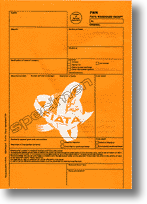 The freight forwarder often provides warehousing services. When doing so he has to issue a receipt for the merchandise. The FWR is a Warehouse Receipt for use in freight forwarders’ warehousing operations. It is a standard document mainly used at national level. The FWR is not a “récépissé-warrant”, which means a formal document recognized as warrant according to the applicable law. When a warehouse keeper is requested to issue a “récépissé-warrant”, the FWR cannot be used. If the issue of a legally recognised document of this kind is not required, the FWR can be issued in almost all cases. Its commercial character is practically the same as that of a “récépissé-warrant”. The FWR incorporates detailed provisions regarding the rights of the holders-by-endorsement of the document, the transfer of ownership, and the agreement that presentation of the warehouse receipt amounts to good delivery of the merchandise. For all practical purposes, such legal functions intended by the use of the FWR are recognized in most jurisdictions. The FWR is not negotiable, unless it is marked “negotiable”.It must be decided individually in each country which standard trading conditions are to be applied to the FIATA warehouse receipt. In countries where forwarders use standard trading conditions which include also provisions regarding the activity of warehouse keepers, such standard conditions are to be applied.
The freight forwarder often provides warehousing services. When doing so he has to issue a receipt for the merchandise. The FWR is a Warehouse Receipt for use in freight forwarders’ warehousing operations. It is a standard document mainly used at national level. The FWR is not a “récépissé-warrant”, which means a formal document recognized as warrant according to the applicable law. When a warehouse keeper is requested to issue a “récépissé-warrant”, the FWR cannot be used. If the issue of a legally recognised document of this kind is not required, the FWR can be issued in almost all cases. Its commercial character is practically the same as that of a “récépissé-warrant”. The FWR incorporates detailed provisions regarding the rights of the holders-by-endorsement of the document, the transfer of ownership, and the agreement that presentation of the warehouse receipt amounts to good delivery of the merchandise. For all practical purposes, such legal functions intended by the use of the FWR are recognized in most jurisdictions. The FWR is not negotiable, unless it is marked “negotiable”.It must be decided individually in each country which standard trading conditions are to be applied to the FIATA warehouse receipt. In countries where forwarders use standard trading conditions which include also provisions regarding the activity of warehouse keepers, such standard conditions are to be applied.
FIATA SDT Shippers Declaration for the Transport of Dangerous Goods
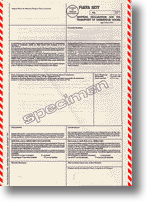 DApart from the documents examined that have been created by FIATA to promote uni-form rules in freight forwarders documents, FIATA also decided to place at the disposal of the freight forwarder a special form for the shipper’s declaration relating to the transport of dangerous goods: the FIATA SDT. If a Freight Forwarder deals with the transport of dangerous goods he needs detailed infor-mation with regard to the classification of the goods according to ADR for the transport by road, RID for the transport by rail and IMDG/IMO for the transport by sea. The clas-sification is shown on the reverse of the form. The Shippers Delcaration of the Transport of Dangerous Goods, FIATA SDT, allows the freight forwarder to identify the goods and to clarify the question of responsibility in case of accident or damage. Therefore it is important that the FIATA SDT is not filled-in by the freight forwarder. In each case the FIATA SDT must be completed and signed by the shipper and then handed over to the freight forwarder.
DApart from the documents examined that have been created by FIATA to promote uni-form rules in freight forwarders documents, FIATA also decided to place at the disposal of the freight forwarder a special form for the shipper’s declaration relating to the transport of dangerous goods: the FIATA SDT. If a Freight Forwarder deals with the transport of dangerous goods he needs detailed infor-mation with regard to the classification of the goods according to ADR for the transport by road, RID for the transport by rail and IMDG/IMO for the transport by sea. The clas-sification is shown on the reverse of the form. The Shippers Delcaration of the Transport of Dangerous Goods, FIATA SDT, allows the freight forwarder to identify the goods and to clarify the question of responsibility in case of accident or damage. Therefore it is important that the FIATA SDT is not filled-in by the freight forwarder. In each case the FIATA SDT must be completed and signed by the shipper and then handed over to the freight forwarder.
FIATA FFI – FIATA Forwarding Instructions
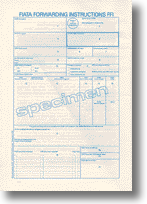 Freight Forwarders mostly design and print their own forwarding instructions forms which have to be filled in by their clients. However, the instruction forms of the various freight for-warders are non-uniform. FIATA therefore thought, that it would be ad-visable for Freight Forwarders to agree on a common layout and drafted the FIATA Model for Uniform Forwarding Instructions. The form is aligned to the UN layout key for trade docu-ments, which aims at providing an inter-national basis for the standardization of docu-ments used in international trade. The form is designed to be used in the alined series and to combine functions in sets of forms, of which integral parts serve various purposes in the procedures for cargo hand-ling. The member organisations of FIATA may adapt this instruction form to their national re-quirements, however, it is fundamental that such changes are made within the margin of the UN layout key. FIATA A recommends its national member orga-nizations to adopt and to introduce this in-struction form, as it is an important tool to improve professional standards and willserve to foster the corporate identity of our trade.
Freight Forwarders mostly design and print their own forwarding instructions forms which have to be filled in by their clients. However, the instruction forms of the various freight for-warders are non-uniform. FIATA therefore thought, that it would be ad-visable for Freight Forwarders to agree on a common layout and drafted the FIATA Model for Uniform Forwarding Instructions. The form is aligned to the UN layout key for trade docu-ments, which aims at providing an inter-national basis for the standardization of docu-ments used in international trade. The form is designed to be used in the alined series and to combine functions in sets of forms, of which integral parts serve various purposes in the procedures for cargo hand-ling. The member organisations of FIATA may adapt this instruction form to their national re-quirements, however, it is fundamental that such changes are made within the margin of the UN layout key. FIATA A recommends its national member orga-nizations to adopt and to introduce this in-struction form, as it is an important tool to improve professional standards and willserve to foster the corporate identity of our trade.
Source: FIATA, CH-8152 Glattbrugg, Switzerland
 Deutsch
Deutsch  English
English  Français
Français 
